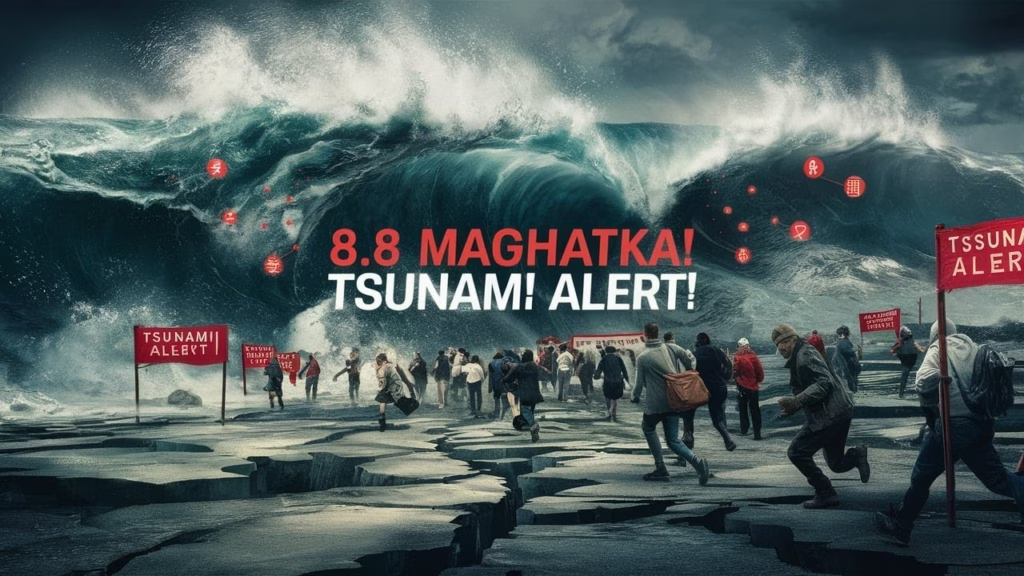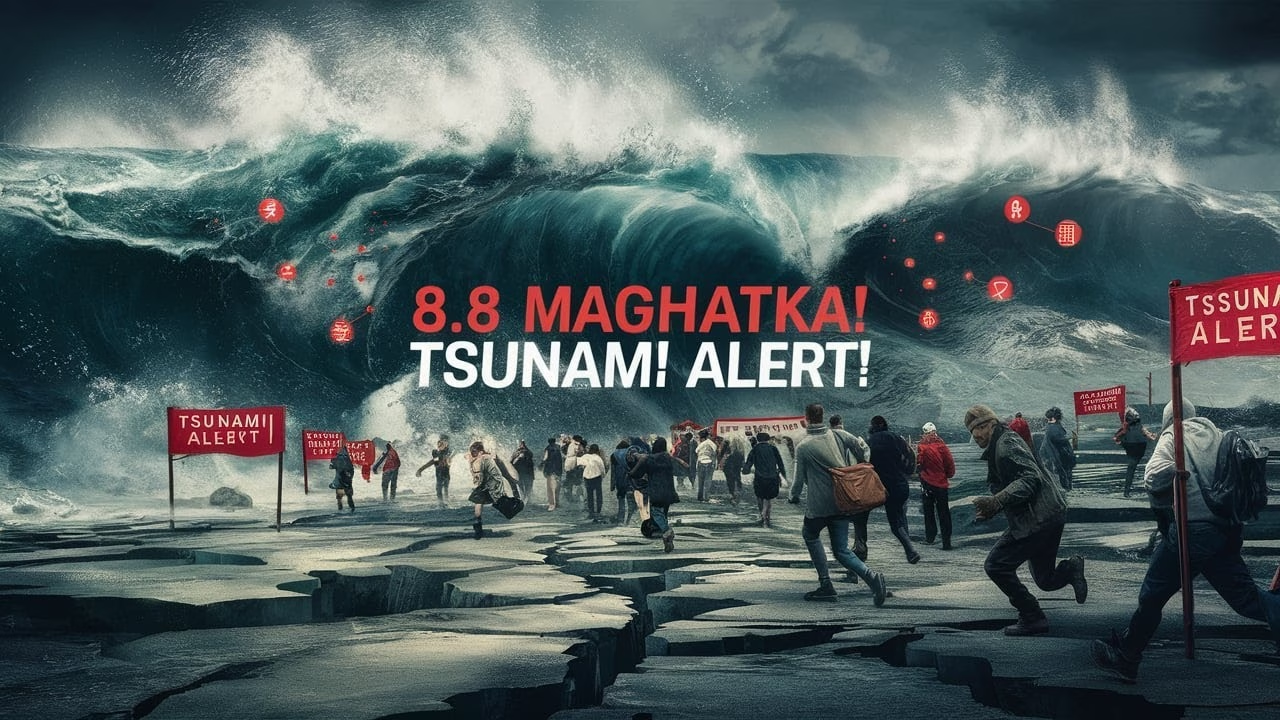A massive 8.8 magnitude earthquake struck just off the eastern coast of Russia’s Kamchatka Peninsula on July 30, 2025, shaking the earth, shattering records, and sending tsunami waves across the Pacific. The seismic event, one of the six strongest earthquakes ever recorded, triggered tsunami alerts in over a dozen countries — from Japan and Hawaii to the west coast of the United States — and forced the evacuation of millions.
The powerful quake, occurring just 125 kilometers southeast of Petropavlovsk-Kamchatsky, has reawakened fears surrounding the Pacific Ring of Fire, and its impact is still unfolding.

⚠️ The Quake That Shook the World
At approximately 4:47 a.m. local time, the undersea megathrust earthquake ripped through the tectonic boundary between the Pacific and Okhotsk plates, producing ground motions strong enough to be felt over 1,000 kilometers away. According to Sky News, the quake’s shallow depth of 19 kilometers only intensified its destructive force.
While the epicenter was far from major population centers, the quake’s violent shockwaves prompted a tsunami warning that echoed across global coastlines, making this more than just a regional disaster.
“This is the largest earthquake in the Kamchatka region since 1952,” according to Barron’s.
🌊 Tsunami Warnings Issued Across the Pacific
In the quake’s aftermath, authorities scrambled to issue Pacific-wide tsunami alerts. Waves between 3 to 4 meters battered the Severo-Kurilsk port in Russia, while the effects of the quake were felt as far as Japan, Alaska, Hawaii, California, Indonesia, and Chile.
As per Politico, over 1.9 million residents in coastal areas of Japan, especially near Fukushima and Hokkaido, were evacuated within hours. Meanwhile, The Times reported emergency sirens blaring across Hawaii, where Governor Talia Otieno issued a state of emergency.
Luckily, the tsunami’s effects on the U.S. mainland were limited. Still, coastal cities like Honolulu saw evacuations and port shutdowns, highlighting how vulnerable even distant regions are when seismic energy travels through ocean basins.
💥 Aftershocks and Structural Damage
The quake was followed by multiple aftershocks, some measuring up to 6.9 magnitude, raising further alarms. VG documented damage in Russian towns and port infrastructure, while NewsDay confirmed power outages and communication breakdowns in parts of the Far East.
Emergency response teams were deployed across Kamchatka and nearby Kuril Islands to assess bridge collapses, port damage, and housing instability. Despite the strength of the quake, no large-scale casualties have been reported so far.
“It’s a miracle,” said a local official. “We’re seeing damage, but thankfully, loss of life has been minimal.”
🌍 A Global Response
The global community responded swiftly. According to MoneyControl, Japan deployed over 22,000 personnel, including police, military, and coast guard, to assist with coastal evacuations. Australia, Chile, and Mexico also issued widespread alerts.
Even countries on the opposite side of the Pacific, like Ecuador, Peru, and New Zealand, put coastal surveillance on high alert. As detailed by Time, this quake demonstrated the interconnected vulnerability of the Pacific basin.
🔍 Why Kamchatka Is a Seismic Hotspot
Located along the infamous Pacific Ring of Fire, the Kamchatka Peninsula is no stranger to seismic events. The region sits atop a subduction zone, where the Pacific plate is slowly diving under the Okhotsk microplate.
According to Indian Express, this area has historically experienced megaquakes, including a 9.0-magnitude quake in 1952 that also caused a deadly tsunami.
Geologists have warned for years that stress was building in the crust here. Watchers News noted over 130 foreshocks and small tremors in the region since mid-July — potentially serving as a precursor to this massive event.
📈 Impact on Global Pop Culture & Events
While natural disasters often seem unrelated to entertainment, the global scope of this event reached music tours, festivals, and live broadcasts. Several Japanese and South Korean artists canceled or postponed performances, including some connected to global stars like BLACKPINK, Lisa, and ATEEZ, who had concerts scheduled near impacted areas.
Likewise, events like the North Sea Jazz Festival (Diana Ross & Norah Jones), and U.S. celebrations like the Macy’s 4th of July Fireworks — which featured stars like Keke Palmer, Trisha Yearwood, and Ariana DeBose — were reshared in news cycles as symbols of unity and resilience amid crisis.
⚠️ The Quake That Shook the World
At approximately 4:47 a.m. local time, the undersea megathrust earthquake ripped through the tectonic boundary between the Pacific and Okhotsk plates, producing ground motions strong enough to be felt over 1,000 kilometers away. According to Sky News, the quake’s shallow depth of 19 kilometers only intensified its destructive force.
While the epicenter was far from major population centers, the quake’s violent shockwaves prompted a tsunami warning that echoed across global coastlines, making this more than just a regional disaster.
“This is the largest earthquake in the Kamchatka region since 1952,” according to Barron’s.
🌊 Tsunami Warnings Issued Across the Pacific
In the quake’s aftermath, authorities scrambled to issue Pacific-wide tsunami alerts. Waves between 3 to 4 meters battered the Severo-Kurilsk port in Russia, while the effects of the quake were felt as far as Japan, Alaska, Hawaii, California, Indonesia, and Chile.
As per Politico, over 1.9 million residents in coastal areas of Japan, especially near Fukushima and Hokkaido, were evacuated within hours. Meanwhile, The Times reported emergency sirens blaring across Hawaii, where Governor Talia Otieno issued a state of emergency.
Luckily, the tsunami’s effects on the U.S. mainland were limited. Still, coastal cities like Honolulu saw evacuations and port shutdowns, highlighting how vulnerable even distant regions are when seismic energy travels through ocean basins.
💥 Aftershocks and Structural Damage
The quake was followed by multiple aftershocks, some measuring up to 6.9 magnitude, raising further alarms. VG documented damage in Russian towns and port infrastructure, while NewsDay confirmed power outages and communication breakdowns in parts of the Far East.
Despite its massive scale, the earthquake has, thus far, resulted in few fatalities, though several injuries have been confirmed. Roads cracked, harbors flooded, and local businesses faced serious losses.
🌍 A Global Response
As noted by MoneyControl, Japan deployed over 22,000 emergency personnel to assist with coastal evacuations and shelter logistics. Australia, New Zealand, Chile, and other Pacific nations activated tsunami defense protocols.
Even international artists postponed travel and performances, including BLACKPINK, Lisa, ATEEZ, and others.
🔍 Kamchatka: A Seismic Hotspot
The Kamchatka Peninsula sits on one of Earth’s most active seismic belts: the Pacific Ring of Fire. This region is no stranger to deadly earthquakes, including the 9.0 magnitude 1952 event that led to catastrophic loss of life.
According to Indian Express, subduction of the Pacific Plate beneath the Okhotsk Plate continues to generate high-magnitude earthquakes regularly.
Recent tremors tracked by Watchers News suggest a pattern of foreshocks leading up to the July 30 quake.
🎤 Culture, Concerts, and Cancelations
Natural disasters impact culture as much as they do infrastructure. Multiple events and broadcasts were rescheduled following the earthquake.
On our blog, you can revisit recent highlights including:
- Keke Palmer – Macy’s Fireworks 2025
- Trisha Yearwood Performance
- Eric Church Live Recap
- Diana Ross and Norah Jones at North Sea Jazz
- Sabrina Carpenter – BST Hyde Park
- Stormzy at Roskilde
- Jonas Brothers Fireworks Recap
- Imagine Dragons at Stade de France
For talent-based highlights:
- Andrea (AGT Hula Hooper)
- Gendai Laser Show
- Anna Saranina AGT 2025
- Adam Boreland AGT Performance
- Nas Orchestral in Atlanta
- Charli XCX at Roskilde
✉️ Final Thoughts
The Kamchatka earthquake of 2025 is a stark reminder of Earth’s unpredictable power. While the region was partially prepared, the sheer scale of this event stretched emergency services and triggered global alerts.
Our team at UltimateRecaps.com will continue monitoring the situation. In the meantime, revisit some of our most read posts:
- Dirtiest Songs of All Time
- Music: Enhypen VEVO Set
- BLACKPINK Goyang Recap
- Love Supreme Festival Day 3
Stay informed, stay safe.

Thanks for your help and for writing this post. It’s been great. http://www.kayswell.com
You’ve the most impressive websites. http://www.kayswell.com
https://shorturl.fm/lReBx
Thanks for posting. I really enjoyed reading it, especially because it addressed my problem. http://www.kayswell.com It helped me a lot and I hope it will help others too.
Thanks for posting. I really enjoyed reading it, especially because it addressed my problem. http://www.kayswell.com It helped me a lot and I hope it will help others too.
Your articles are extremely helpful to me. May I ask for more information? http://www.ifashionstyles.com
Thank you for writing this article. I appreciate the subject too. http://www.kayswell.com
Please tell me more about this. May I ask you a question? http://www.kayswell.com
How can I find out more about it? http://www.kayswell.com
Thank you for writing this post. I like the subject too. http://www.kayswell.com
I’m so in love with this. You did a great job!! http://www.kayswell.com
Aw, this was a very nice post. Taking the time and actual effort to create a great article… but what can I say… I hesitate a whole lot and never seem to get nearly anything done.